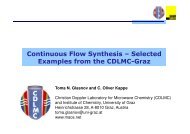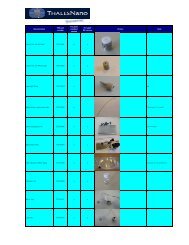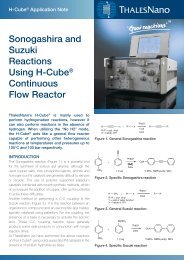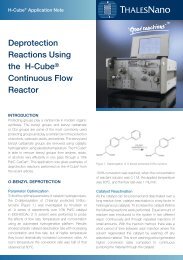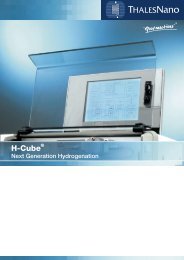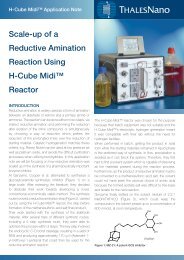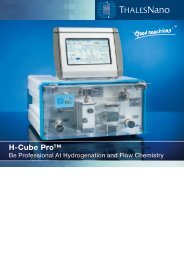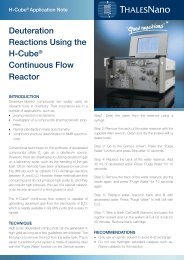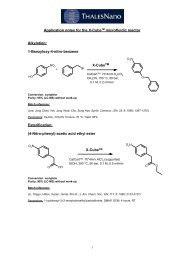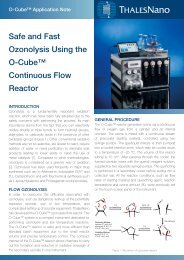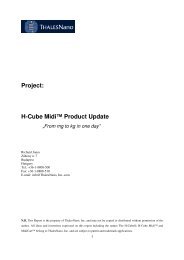O-Cube™ and H-Cube® Application Note - ThalesNano
O-Cube™ and H-Cube® Application Note - ThalesNano
O-Cube™ and H-Cube® Application Note - ThalesNano
You also want an ePaper? Increase the reach of your titles
YUMPU automatically turns print PDFs into web optimized ePapers that Google loves.
O-Cube <strong>and</strong> H-Cube ®<br />
<strong>Application</strong> <strong>Note</strong><br />
Ozonolysis<br />
Combined with<br />
Hydrogenation for<br />
the Simple<br />
Synthesis of<br />
Aldehydes in<br />
T<strong>and</strong>em<br />
Continuous Flow<br />
INTRODUCTION<br />
While ozonolysis itself is a useful reaction in organic<br />
chemistry it is not performed regularly because of its<br />
hazardous nature. Under common laboratory conditions,<br />
the ozonide can decompose explosively during the<br />
quenching process because of its highly exothermic<br />
nature. Stringent safety regulations need to be obeyed<br />
to avoid this. In order to increase adoption of this useful<br />
technique, <strong>ThalesNano</strong> developed the O-Cube<br />
ozonolysis reactor which is designed to make ozonolysis<br />
safer by quenching the potentially explosive ozonides<br />
continuously on a small scale. The small scale nature of<br />
fl ow means that the temperature of both reaction steps<br />
is precisely controlled, signifi cantly lowering the risk of a<br />
runaway reaction. The other downside to ozonolysis is<br />
that many quenching reagents, such as PPh 3 or NaBH 4<br />
require extensive work up, while alternatives such as<br />
DMS give off an unpleasant odour. In order to enhance<br />
the performance of the O-Cube reactor further <strong>and</strong><br />
simplify the workup procedure after ozonolysis, we have<br />
developed the combination of two fl ow systems where<br />
the intermediate of the ozonolysis reaction is converted to<br />
fi nal product via hydrogenation in the H-Cube ® continuous<br />
fl ow system (Figure 1). The setup also contains a<br />
ReactIR fl ow-cell, so the reactions can be monitored<br />
in real-time <strong>and</strong> optimized rapidly in order to reach a<br />
high selectivity through precise residence time control.<br />
Figure 1. T<strong>and</strong>em Continuous Flow Reactor <strong>and</strong> Analysis Setup
O-Cube <strong>and</strong> H-Cube ® <strong>Application</strong> <strong>Note</strong><br />
GENERAL PROCEDURE<br />
After setting up the corresponding reaction parameters<br />
(see Table 1), the O-Cube reactor was started in Auto<br />
Mode. In the meantime parameters on the H-Cube ®<br />
system were also set <strong>and</strong> the catalyst in the CatCart ®<br />
column was preactivated by passing solvent through the<br />
system in the presence of hydrogen.<br />
The ozonide solution from the O-Cube instrument was<br />
collected into a cooled (-30 °C) small sample vial. The<br />
solution was purged with nitrogen in order to drive out<br />
any excess of ozone prior to pumping into the H-Cube®<br />
instrument. The product (aldehyde) was collected at the<br />
outlet of the device.<br />
In order to decrease the time spent for optimization of<br />
the reaction we have used a FT-IR inline monitoring by<br />
integrating the flow cell of the ReactIR (product of Mettler<br />
Toledo Autochem Inc.) <strong>and</strong> making measurements in the<br />
near IR range (650-4000 cm -1 ) every 30 secs.<br />
Before running each reaction, reference spectra of the<br />
solvent, the starting material <strong>and</strong> product were recorded,<br />
<strong>and</strong> the peaks of the solvent were subtracted from the<br />
starting material <strong>and</strong> product spectra. In the case of<br />
the products <strong>and</strong> starting materials we needed to find<br />
a specific wave number where the ReactIR system<br />
was able to continuously monitor the intensity of each<br />
compound (Figure 2) over time. The optimal reaction<br />
conditions were identified when the maximum intensity<br />
of the product could be recorded <strong>and</strong> where the peak of<br />
the starting material disappeared (Figure 3). The product<br />
mixture collected under the optimal conditions was<br />
evaporated to yield the product. The optimal conditions<br />
for each reaction <strong>and</strong> results can be seen in Table 1.<br />
Reaction Reaction conditions Result<br />
Table 1: Reaction conditions <strong>and</strong> results, *: by 1 H-NMR, **: by TLC<br />
c = 0.02 M in DCM<br />
O-Cube: -30 °C, 1 mL/min,<br />
50% O 3 excess<br />
H-Cube ® : RT, 30 bar, 1mL/min,<br />
10% Pd/C<br />
c = 0.04 M in EtOAc<br />
O-Cube: -28 °C, 1 mL/min,<br />
50% O 3 excess<br />
H-Cube ® : RT, 30 bar, 1mL/min,<br />
10% Pd/C<br />
c = 0.06 M in DCM<br />
O-Cube: -9 °C, 0.7 mL/min,<br />
50% O 3 excess<br />
H-Cube ® : RT, 30 bar, 0.7 mL/min,<br />
10% Pd/C<br />
c = 0.07 M in EtOH<br />
O-Cube: -28 °C, 0.7 mL/min,<br />
30% O 3 excess<br />
H-Cube ® : RT, 30 bar, 0.7 mL/min,<br />
10% Pd/C<br />
Isolated yield: 85%<br />
Purity*: >95%<br />
Conversion**:<br />
quantitative<br />
Isolated yield: 80%<br />
Purity*: 90%<br />
Conversion**:<br />
quantitative<br />
Isolated yield: 77%<br />
Purity*: 100%<br />
Isolated yield: 50%<br />
Purity*: 100%
%<br />
100<br />
90<br />
80<br />
70<br />
60<br />
50<br />
40<br />
30<br />
20<br />
10<br />
0<br />
4000 3800 3600 3400 3200<br />
Wavenumber (cm-1 3000<br />
Mettler Toledo<br />
2800 2600 2400 2200 2000 1800 1600 1400 1200 1000<br />
)<br />
800 600<br />
Peak Height (A.U.)<br />
0.060<br />
0.040<br />
Starting of the reaction<br />
0.020<br />
CONCLUSION<br />
We were able to perform two hazardous reactions,<br />
ozonolysis <strong>and</strong> hydrogenation, in a safe manner. We have<br />
demonstrated that the combination of two continuous<br />
flow instruments led to a significant speeding up of the<br />
work up process. To obtain the product only evaporation<br />
of solvent needed to be performed. No extensive work<br />
up procedure was necessary. The optimization time was<br />
reduced dramatically by employing the ReactIR system<br />
to monitor the reactions in real time. In light of these<br />
results it can be stated that we have worked out a green<br />
<strong>and</strong> effective process for the synthesis of aldehydes via<br />
ozonolysis <strong>and</strong> hydrogenation.<br />
LEGAL INFORMATION<br />
H-Cube <strong>and</strong> CatCart are registered trademarks, <strong>and</strong><br />
O-Cube is a trademark of <strong>ThalesNano</strong> Inc., ReactIR is a<br />
trademark of Mettler-Toledo Autochem Inc..<br />
Figure 2: Inline FT-IR monitoring of ozonolysis of 3-nitro-styrol<br />
00:20:00 00:30:00 00:40:00 00:50:00 01:00:00<br />
Mettler Toledo<br />
Relative Time<br />
Figure 3. Reaction monitoring<br />
O-Cube <strong>and</strong> H-Cube ® <strong>Application</strong> <strong>Note</strong><br />
— 3-nitro-benzaldehyde: 1708 (1200, 1610) cm -1<br />
— 3-nitro-styrol: 925 (991, 795) cm -1<br />
Ending of the reaction<br />
— 3-nitro-styrol<br />
— 3-nitro-benzaldehyde<br />
REFERENCES<br />
[1] Irfan, M.; Glasnov, T. N.; Kappe, C.O.; Continuous<br />
flow ozonolysis in a laboratory scale reactor; Org.<br />
Lett.; 2011; 13 (5); 984-7<br />
[2] Carter, C.F.; Lange, H.; Baxendale, I.R.; Ley, S.V.;<br />
Goode, J.; Gaunt, N.; Wittkamp, B.; ReactIR<br />
Flow Cell – A New Analytical Tool for Continuous<br />
Flow Chemistry Processing; Org. Proc. Res. Dev.;<br />
2010; 14; 393-404
O-Cube<br />
Ozonolysis Reinvented<br />
The O-Cube is a ground breaking fl ow reactor designed<br />
to make ozonolysis <strong>and</strong> other low temperature reactions<br />
easier <strong>and</strong> safer to perform. The O-Cube makes<br />
ozonolysis safe enough to be performed in any lab environment<br />
by any level of chemist, so companies need not<br />
avoid or work around this important process any longer.<br />
Specifi cations of O-Cube<br />
Flow rate range: 0.1 – 3 mL/min<br />
Ambient to -25 °C (lower<br />
Temperature range: temperature is possible with<br />
additional setup)<br />
Pressure range: 1 bar (max. 6 bar)<br />
O /O production range: 2 3 5 – 20 mL/min<br />
Ozone production: 7 - 15% wt<br />
Width: 364 mm (14.33”)<br />
Dimensions:<br />
Height: 471 mm (18.54”)<br />
Depth: 495.5 mm (19.51”)<br />
Weight: 54 kg (119 lbs)<br />
Voltage: 115 VAC - 230 VAC<br />
Frequency: 50 - 60 Hz<br />
Power consuption: Max. 600 VA<br />
<strong>ThalesNano</strong> Nanotechnology Inc.<br />
Zahony u. 7.<br />
H-1031 Budapest<br />
Hungary<br />
Tel.: +36 1 880 8500<br />
Fax: +36 1 880 8501<br />
E-mail: sales@thalesnano.com<br />
US Offi ce <strong>ThalesNano</strong><br />
50 S. Penn St. Suite B-2<br />
Hatboro<br />
PA. 19040<br />
USA<br />
Phone: +1 215 443 2430<br />
E-mail: USAsales@thalesnano.com<br />
O-Cube <strong>and</strong> H-Cube ® <strong>Application</strong> <strong>Note</strong><br />
H-Cube ®<br />
Continuous Flow Hydrogenation Reactor<br />
A revolutionary bench-top st<strong>and</strong>alone hydrogenation<br />
reactor, uniquely combining continuous-fl ow microchemistry<br />
with endogenous on-dem<strong>and</strong> hydrogen generation<br />
<strong>and</strong> a disposable catalyst cartridge system. It allows fast<br />
<strong>and</strong> cost-effi cient hydrogenation with superior yield when<br />
compared to conventional methods.<br />
Specifi cations of H-Cube ®<br />
Flow rate range: 0.1 - 3 mL/min<br />
Temperature range: Ambient to 100 °C<br />
Pressure range: 1 bar to 100 bar<br />
H production:<br />
2<br />
30 cm3 /min in Full Hydrogen Mode<br />
7 gas/liquid % in Controlled Mode<br />
Width: 26 cm (10.2”)<br />
Dimensions:<br />
Height: 29 cm (11.4”)<br />
Depth: 44 cm (17.3”)<br />
Weight: 12 kg (27 lbs)<br />
Voltage: 100 VAC - 240 VAC<br />
Frequency: 47 - 63 Hz<br />
UK Offi ce<br />
Carl Jones<br />
Head of European Sales<br />
Tel.: +44 2088 167 034<br />
E-mail: UKsales@thalesnano.com



